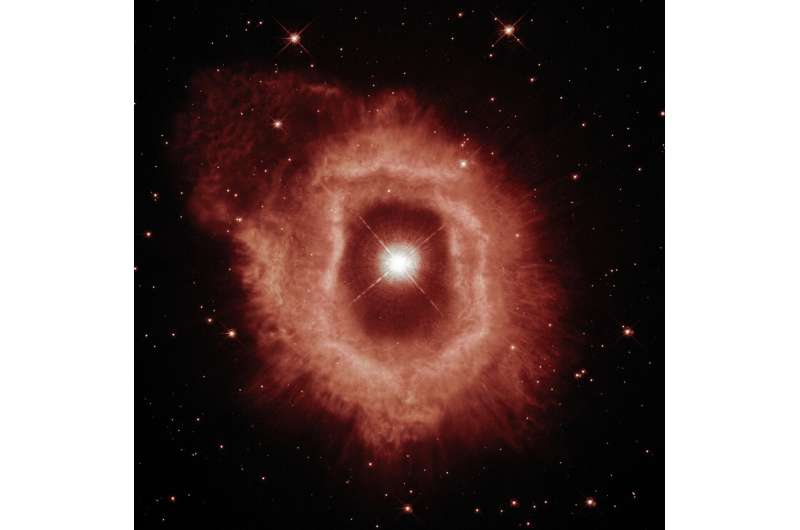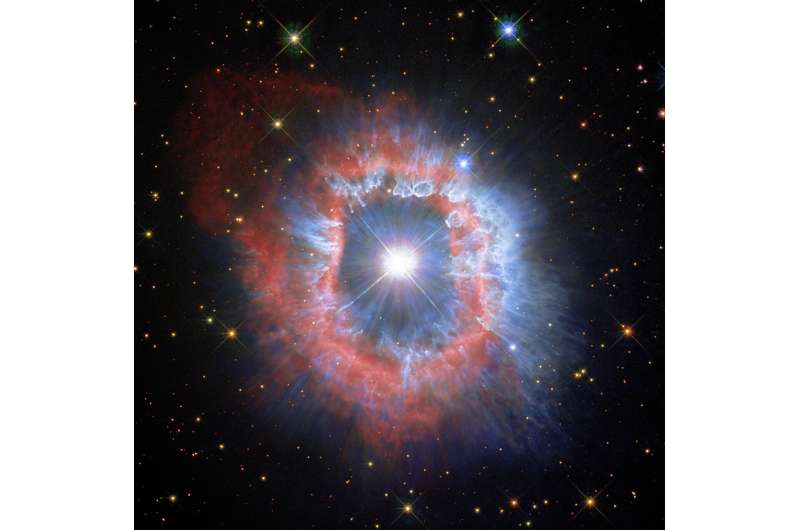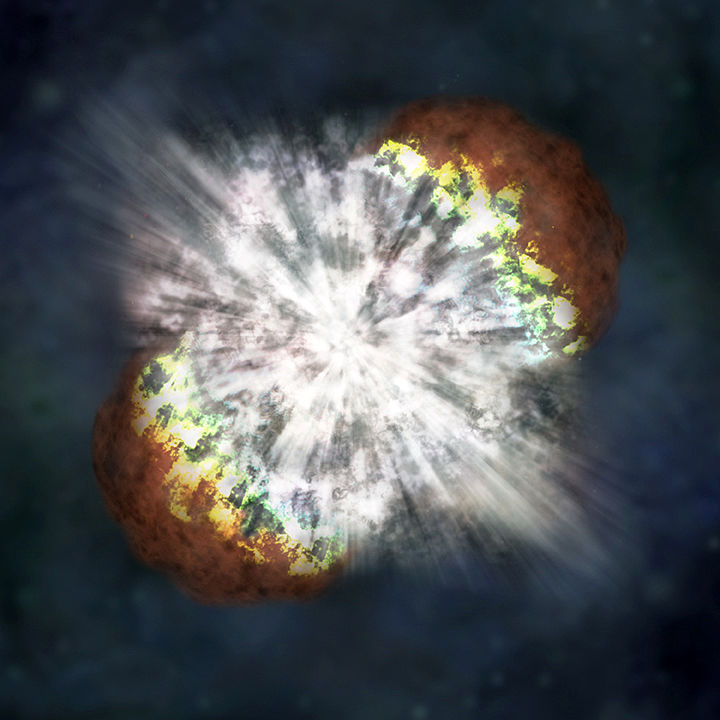Hubble takes 31st anniversary image: Two new views showcase the dual nature of the star AG Carinae

Comparing two images shows puffing dust bubbles and an erupting gas shell—the final acts of a monster star's life.
These new views showcase the dual nature of the star AG Carinae, which was the target of the NASA/ESA Hubble Space Telescope's 31st anniversary image in April 2021. This new perspective is the result of Hubble's observations of the star in 2020 and 2014, along with others captured by the telescope's Wide Field Planetary Camera 2 in 1994.
The first image showcases details of ionized hydrogen and nitrogen emissions from the expanding shell of the nebula (seen here in red). In the second image, the color blue delineates the distribution of dust that shines in reflected star light. Astronomers think powerful stellar winds coming off of the star formed and shaped the dust bubbles and filaments. The nebula is about five light-years wide, similar to the distance from here to the nearest star beyond the Sun, Proxima Centauri.
AG Carinae is formally classified as a luminous blue variable because it is a hot (emitting blue light), brilliant star that varies in brightness. Such stars are quite rare because few are so massive. Luminous blue variable stars continuously lose mass in the final stages of life. The star is waging a tug-of-war between gravity and radiation pressure to avoid self-destruction. As the star begins to run out of fuel, its radiation pressure decreases, and gravity begins to take hold. Stellar material succumbs to gravity and falls inward. It heats up and is explosively ejected into the surrounding interstellar space. This process continues until enough mass is lost and the star reaches a stable state.

The spectacular nebula surrounding AG Carinae formed by material ejected from the star during several of its past outbursts. The nebula is approximately 10,000 years old, and the observed velocity of the gas is approximately 43 miles per second. While this nebula looks like a ring, it is in fact a hollow shell whose center was cleared of gas and dust by a powerful stellar wind traveling roughly 124 miles per second. The gas (composed mostly of ionized hydrogen and nitrogen) in these images appears as a thick bright red ring, which appears doubled in places—possibly the result of several outbursts colliding into each other. The dust, seen here in blue, formed in clumps, bubbles, and filaments and was shaped by the stellar wind.
Scientists who observed the star and its surrounding nebula note that the ring is not perfectly spherical. It appears to have bipolar symmetry. This could mean the mechanism producing the outburst may be the result of a disk in the center, or the star may have a companion (known as a binary star). An alternative and simpler theory is that, like many massive stars, AG Carinae may rotate very fast.

The NASA Hubble Space Telescope celebrated its 31st anniversary observing the final moments of a dying star. AG Carinae, estimated to be 70 times more massive than the Earth's Sun, was captured in two spectacular photos.
The massive star is one of the brightest stars seen in the solar system. It is a few million years old and resides about 20,000 light-years away. NASA classified AG Carinae as a Luminous Blue Variable because of its hot and blue light brightness. Such stars are rare because very few grow to be so massive.
In the photo captured, AG Carinae erupted with a shell of gas and dust. NASA explained in detail the events surrounding the star.
Final Moments of Dying Star: NASA Hubble Images
There are many interesting and observable facts about AG Carinae. In the photo tweeted above, ionized hydrogen and nitrogen emissions create the red shell. The second image captured with a blue ring is the dust that shines around the core, reflected by starlight. The whole nebula is approximately five light-years wide, which means a distance from the Sun to the next nearest star, Proxima Centauri.
According to NASA, the circular formation around the nebula is created by a galactic tug-of-war between AG Carinae's gravity and radiation, which would continue until the star reaches a stable state.
To summarize, when the star loses radiation, gravity pulls nearby stellar material inward. This heats up the star, which explosively ejects the energy, creating the beautiful rings. Note that no other stars exist in the space between AG Carinae and its outer rings. All the material between is neatly expelled during the explosion.
It is worth noting that AG Carinae and its nebula ring are not perfectly spherical. Astronomers think that powerful stellar winds influenced its shape during an explosion. A YouTube explanation by NASA is embedded below.
The astronomical event was analyzed and explained thanks to Hubble Telescope's observations on the star from 2020 and 2014. The photo captured was taken from Hubble's Wide Field Planetary Camera 2, installed in 1994.
Despite being decades old, Hubble continues to contribute several unique and exciting space discoveries. NASA posted a Hubble Trivia explaining some of its achievements:
NASA's Hubble Space Telescope was launched on April 24, 1990 and has made over 1.5 million observations about 48,000 celestial objects.
The 31-year-old telescope made more than 181,000 orbits around Earth, totaling over 4.5 billion miles.
Hubble observations have produced more than 169 terabytes of data available for present and future generations of researchers.
Astronomers using Hubble data have published more than 18,000 scientific papers, with more than 900 of those papers published in 2020.
Fortunately, space researchers said that Hubble is in pristine condition. The iconic space observatory should still contribute many more discoveries in the years to come.
Related Article: NASA Reveals Plan to Crash Spaceship to Deflect Massive Asteroid: Full Simulation, Mission Launch Date and MORE
No comments:
Post a Comment